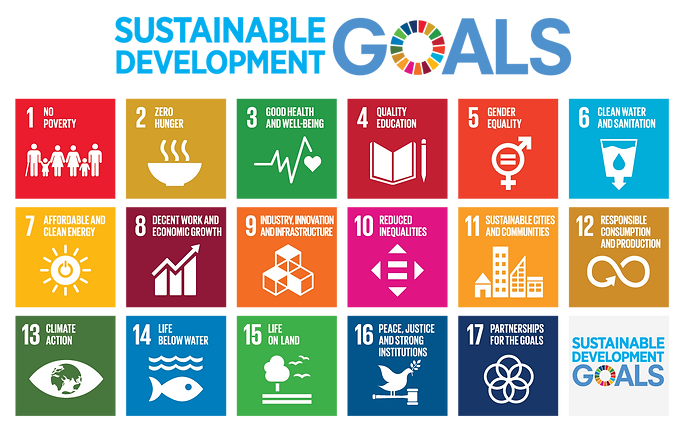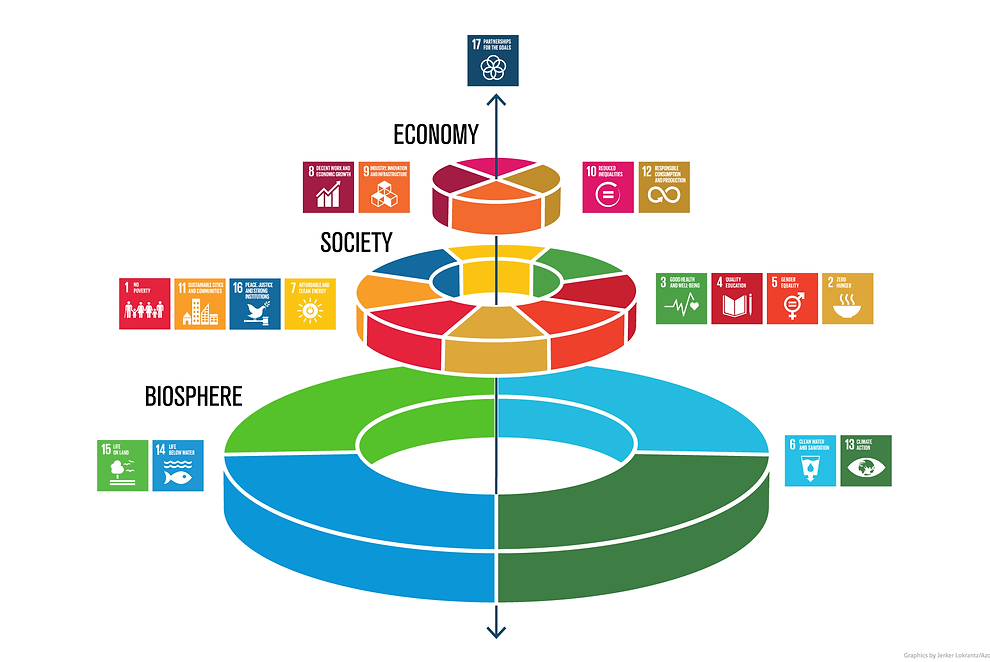The 2030 Agenda of the United Nations provides humanity with a target space for sustainable development. The Agenda 2030 presents an internationally agreed-upon set of 17 Sustainable Development Goals (SDGs) along with 169 targets. Each target has one or more indicators to measure progress and compliance. The SDGs are ‘integrated and indivisible’ – each of the SDGs is more or less dependent on other SDGs and cannot be achieved in isolation.

Illustration: un.org
Attaining the SDGs within the planetary boundaries
By being ‘integrated and indivisible’, the SDGs balance the three dimensions of sustainable development – economic, social and environmental. Importantly, this implies that human economies and societies are embedded parts of the Biosphere. As such, the Biosphere provides the life support systems upon which prosperity and development ultimately rest. The economy is a subsystem of society – and, in turn, a subsystem of the Biosphere – that should serve humanity to thrive within the means of the Biosphere.

Illustration: J. Lokrantz/Azote
Scenario planning and the Agenda 2030
In an ideal world the interactions between SDGs result in co-benefits and synergies. In practice, however, the interactions between SDGs often result in tradeoffs and tensions, frustrating sustainable development. For example, intensive agriculture for food production (SDG2) tends to result in biodiversity loss on land (SDG15) and in water (SDG16).
Scenario planning is a powerful tool for navigating sustainable development towards achieving the Agenda 2030. The analysis of contrasting futures illuminates trade-offs and win-wins in complex social-ecological systems. Moreover, through the creation of visions and stories of the future people can better determine what kind of futures they want. Participatory scenario planning in particular can be used to capture and express the diversity and plurality of people’s beliefs, values and aspirations for a sustainable future. Combined, this information helps to pinpoint which interactions between SDGs need to change to attain desired futures.
Biosphere Futures and the Agenda2030
The collection of scenario case studies in the Biosphere Futures database provides a rich assortment of perspectives on the future. Already, Biosphere Futures can be used to analyze which combinations of SDGs are addressed by place-based social-ecological scenario studies in different social-ecological contexts, and which SDGs are ignored. As a next development step we plan to bring in more details for each case studies, to enable more detailed analyses of the interactions between the SDGs addressed by social ecological scenario case studies across the planet.
Key references
Folke C., Biggs R., Norström A.V., Reyers, B. & Rockström J. 2016. Social-ecological resilience and biosphere-based sustainability science. Ecology and Society 21(3):41. http://dx.doi.org/10.5751/ES-08748-210341
Norström A.V. & colleagues. 2014. Three necessary conditions for establishing effective Sustainable Development Goals in the Anthropocene. Ecology and Society 19(3): 8. http://dx.doi.org/10.5751/ES-06602-190308
Jiménez-Aceituno A., Peterson G.D., Norström A.V., Wong, G.Y., Downing A.S. 2019. Local lens for SDG implementation: lessons from bottom-up approaches in Africa. Sustainability Science. https://doi.org/10.1007/s11625-019-00746-0
Selomane O., Reyers B., Biggs R. & Hamann M. 2019. Harnessing Insights from Social-Ecological Systems Research for Monitoring Sustainable Development. Sustainability 11(4):1190. https://doi.org/10.3390/su11041190
Stafford-Smith, M. & colleagues. 2017. Integration: the key to implementing the Sustainable Development Goals. Sustainability Science 12: 911. https://doi.org/10.1007/s11625-016-0383-3